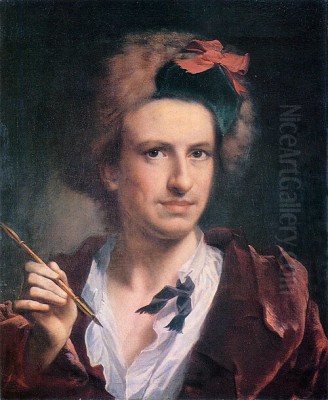
Francesco Bartolozzi stands as a towering figure in the history of European printmaking, an Italian-born artist whose career flourished primarily in London, leaving an indelible mark on the art of engraving during the late 18th and early 19th centuries. Renowned for his technical brilliance, particularly in the stipple engraving technique, and his elegant, Neoclassical style, Bartolozzi translated the works of Old Masters and contemporary painters into prints of exceptional quality and sensitivity. His life spanned a period of significant artistic change, and his work reflects the transition from the late Baroque and Rococo to the prevailing Neoclassicism of his time. Born in Florence in 1727 and passing away in Lisbon in 1815, his journey took him from the heart of the Italian Renaissance legacy to the bustling art centres of Venice, Rome, London, and finally Lisbon, establishing an international reputation that endures to this day.
Florentine Foundations and Early Training
Francesco Bartolozzi was born in Florence, the cradle of the Italian Renaissance, into a world steeped in artistic tradition. While sources present slight discrepancies regarding his exact birth date, citing either September 21st or 27th, the year 1727 is widely accepted. His father, Gaetano Bartolozzi, was a goldsmith and silversmith, providing young Francesco with his earliest exposure to the meticulous craft of working with metal and engraving tools. This familial background undoubtedly instilled in him a foundational understanding of fine metalwork and design principles from a very young age. Records suggest his innate talent for drawing and engraving was apparent early on, possibly by the age of ten.
Recognizing his son's artistic inclinations, Gaetano ensured Francesco received formal training. He was enrolled at the prestigious Accademia di Belle Arti di Firenze (Florence Academy of Fine Arts). There, he studied painting under the guidance of respected Florentine artists Ignazio Hugford, an artist of English descent known for his historical paintings and connoisseurship, and Giovanni Domenico Ferretti, a prolific painter working in the late Baroque and Rococo styles. This initial training provided Bartolozzi with a solid grounding in drawing, composition, and the handling of colour, evident in the painterly quality of his later engravings.
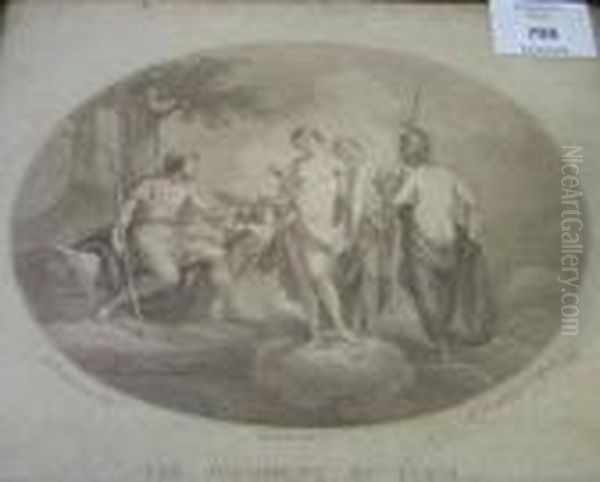
Although he initially trained as a painter, Bartolozzi soon found his true calling in the art of engraving. Florence, while past its Renaissance zenith, remained an important artistic centre, and the young artist absorbed its rich visual culture. His early studies exposed him to the works of the great Florentine masters, fostering a deep appreciation for anatomical accuracy and graceful figural representation that would become hallmarks of his mature style. This comprehensive artistic education in Florence laid the essential groundwork for his future success.
Venetian Apprenticeship and Roman Sojourn
Seeking to specialize and refine his skills in engraving, Bartolozzi moved to Venice around 1745. Venice at this time was a vibrant artistic hub, home to celebrated painters like Giovanni Battista Tiepolo and Canaletto, and a major centre for printmaking and publishing. This move was pivotal for Bartolozzi's development as an engraver. He entered the workshop of Joseph Wagner (also known as Giuseppe Wagner), a highly successful engraver and print publisher originally from Thalendorf on Lake Constance, who had established a prominent studio in Venice.
Wagner's workshop was one of the most important in Europe, producing a vast number of prints, including reproductions of popular paintings, decorative subjects, and portraits. Under Wagner's tutelage, Bartolozzi honed his technical skills in both etching and line engraving. He learned the commercial aspects of the print trade and gained experience working on diverse projects. During his time with Wagner, which lasted until about 1751, Bartolozzi collaborated on several significant plates and began to develop his own distinctive, fluid style. His apprenticeship provided invaluable practical experience and connected him to a wider European network of artists and publishers.
Following his productive years in Venice, Bartolozzi spent time in Rome. The Eternal City, with its unparalleled access to classical antiquities and High Renaissance masterpieces, further deepened his understanding of form and composition. While details of his Roman period are less documented, it is known that he continued to work as an engraver, possibly undertaking commissions or further studies. This immersion in the classical tradition profoundly influenced his artistic sensibilities, reinforcing the Neoclassical tendencies that would later define his work in London. His Italian period, encompassing Florence, Venice, and Rome, equipped him with exceptional technical facility and a sophisticated artistic vocabulary.
The Call to London and Royal Patronage
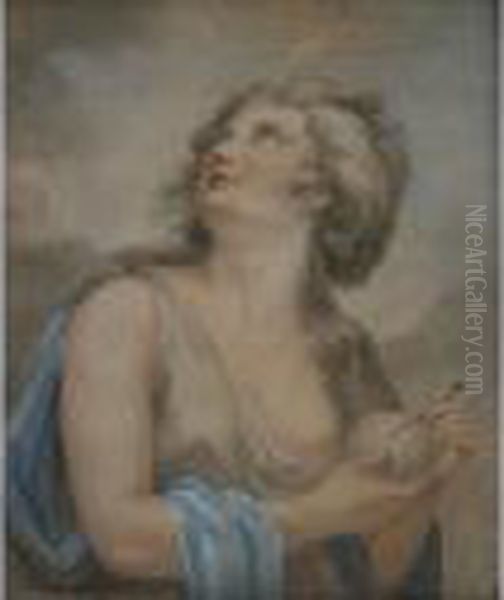
The year 1764 marked a decisive turning point in Francesco Bartolozzi's life and career. He received an enticing invitation to relocate to London, extended by Richard Dalton, the librarian to King George III and a notable figure in the London art world. Dalton, tasked with acquiring art and artists for the King, recognized Bartolozzi's exceptional talent, likely having encountered his work during travels in Italy. The offer included a substantial annual salary of £300 to work primarily, though not exclusively, for the King.
Bartolozzi accepted the offer and moved to London, a city rapidly becoming a major European centre for the arts and commerce. George III was an enthusiastic patron of the arts and sciences, keen on enriching the Royal Collection and promoting British artistic talent. Bartolozzi's arrival was timely, coinciding with a growing demand for high-quality prints among the British aristocracy and burgeoning middle class. London offered a dynamic environment, a thriving print market, and opportunities for collaboration with leading British artists.
His initial role involved engraving works from the Royal Collection, particularly the extensive collection of drawings by Italian masters. His reproductions of drawings by artists like Guercino (Giovanni Francesco Barbieri) and Annibale Carracci, housed at Windsor Castle, were highly acclaimed for their fidelity and sensitivity. This royal connection immediately established Bartolozzi's reputation in England and provided him with financial stability and prestigious commissions. He was soon appointed "Engraver to the King," a title that cemented his status within the British art establishment.
Pioneering Stipple Engraving in Britain
While Francesco Bartolozzi did not invent stipple engraving, he became its most celebrated practitioner and was largely responsible for its immense popularity in Britain during the late 18th century. Stipple engraving is an intaglio printmaking technique where tone and shading are created using a pattern of dots and short flicks etched or engraved into the copper plate, rather than the parallel lines or cross-hatching characteristic of traditional line engraving. The density and size of the dots determine the depth of tone, allowing for subtle gradations and soft, atmospheric effects.
Bartolozzi recognized the unique potential of the stipple technique, often combined with etching, to replicate the delicate qualities of chalk drawings, wash drawings, and watercolour paintings. This was particularly appealing in an era that valued sensibility and refinement. His mastery lay in his ability to use dots with extraordinary finesse, achieving a softness and tonal range that line engraving struggled to match. He often printed his stipple engravings in coloured inks, particularly sanguine (red-brown) or sepia, further enhancing the resemblance to drawings and adding to their decorative appeal.
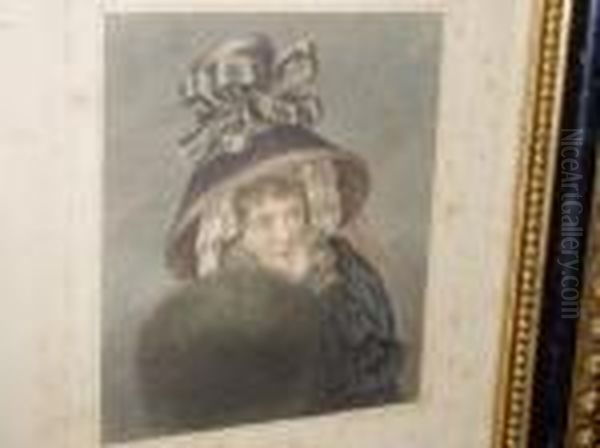
His adoption and refinement of the technique, sometimes referred to as the "red chalk manner" or "dot manner," coincided perfectly with the prevailing Neoclassical and Sentimental tastes. It proved ideal for reproducing the graceful allegories of his friend Giovanni Battista Cipriani, the charming historical and mythological scenes of Angelica Kauffman, and the elegant portraits by Sir Joshua Reynolds and others. Bartolozzi's success popularised stipple engraving to such an extent that it became a dominant technique in British printmaking for several decades, widely imitated by his contemporaries and pupils.
The Bartolozzi Style: Grace, Elegance, and Accuracy
Francesco Bartolozzi's artistic style is characterized by its elegance, grace, and technical refinement. While firmly rooted in his Italian training and deeply influenced by classical ideals, his work developed a distinctive character during his London years. His engravings possess a remarkable fluidity of line, even when employing the stipple technique, which relies on dots. Figures are typically rendered with anatomical accuracy, reflecting his academic training and, according to some accounts, his profound knowledge of human anatomy.
His aesthetic aligned closely with the Neoclassicism favoured by many of his collaborators, emphasizing clarity of form, balanced compositions, and idealized figures often drawn from mythology, classical history, or allegory. However, Bartolozzi infused these subjects with a gentle charm and sometimes a sentimental sweetness that also resonated with Rococo sensibilities and the burgeoning Romantic movement. His figures, whether gods and goddesses, historical personages, or contemporary portraits, often possess a soft, appealing quality, described by some critics as exhibiting a "sweet and gentle beauty."
Bartolozzi demonstrated exceptional skill in rendering textures and capturing the play of light and shadow. His delicate modelling created a sense of volume and softness, particularly effective in depicting flesh tones and drapery. He possessed an innate ability to translate the nuances of a painting or drawing into the engraved medium without losing the spirit of the original. Indeed, contemporaries like Sir Joshua Reynolds reportedly felt that Bartolozzi's engravings sometimes surpassed the quality of the original works they reproduced, a testament to his interpretive skill as well as his technical prowess.
Reproducing the Masters: Old and New
A significant portion of Francesco Bartolozzi's vast output consisted of reproductive engravings, translating paintings and drawings by other artists into prints accessible to a wider audience. His work in this area spanned both Old Masters and contemporary artists, showcasing his versatility and interpretive intelligence. His early work for George III involved engraving drawings from the Royal Collection, most notably the series after Guercino, which earned him considerable acclaim for capturing the energy and freedom of the master's draughtsmanship.
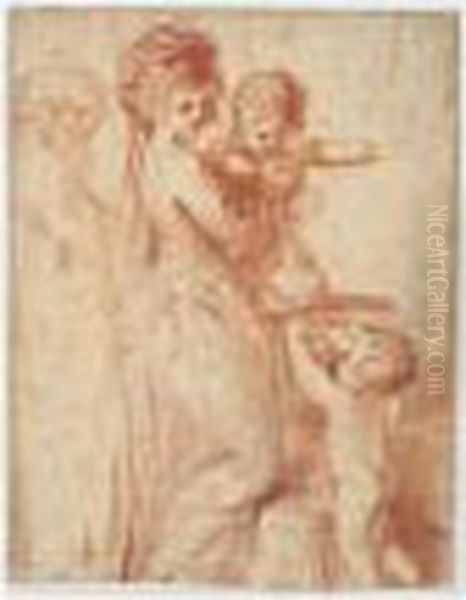
He continued to engrave works by other Italian masters throughout his career, including Annibale Carracci, Carlo Dolci, Correggio, and others. These reproductions played a crucial role in disseminating knowledge of Italian art in Britain before the age of photography. Bartolozzi's prints were not mere copies; they were interpretations that often enhanced the tonal subtleties and refined the compositions of the originals, reflecting his own Neoclassical aesthetic. This led to the somewhat hyperbolic claim by some admirers that he "improved" upon the masters he copied.
Equally important were his engravings after contemporary artists, which formed the core of his commercial success in London. His long and fruitful collaboration with fellow Italian expatriate Giovanni Battista Cipriani resulted in numerous prints characterized by their shared Neoclassical grace. He was the favoured engraver for Angelica Kauffman, translating her popular sentimental and historical subjects into stipple prints that enjoyed enormous public appeal. He also engraved major works by leading British painters, including Sir Joshua Reynolds (portraits and allegorical subjects like Simplicity), Benjamin West (historical scenes), Thomas Gainsborough, Richard Cosway (whose miniatures he adeptly translated), Francis Wheatley (Cries of London series contributions), and the elegant designs of Diana Beauclerk.
Signature Works and Notable Projects
Among Bartolozzi's most celebrated works is the Diploma of the Royal Academy of Arts (1768). Designed by his close friend Giovanni Battista Cipriani, this intricate allegorical composition was expertly engraved by Bartolozzi and serves as the official certificate for members of the Academy to this day. It exemplifies the collaborative synergy between the two artists and showcases Bartolozzi's skill in rendering complex figural groups and symbolic details with clarity and elegance.
Another significant project was his contribution to the engraving of the Marlborough Gems, a famous collection of antique engraved gemstones owned by the Duke of Marlborough. Bartolozzi engraved a number of plates for the privately printed catalogue (published 1780-1791), demonstrating his affinity for classical subjects and his ability to replicate the precision and detail of ancient glyptic art.
Bartolozzi was also a key contributor to John Boydell's ambitious Shakespeare Gallery project, which aimed to foster a British school of history painting through commissioned works based on Shakespeare's plays, subsequently disseminated through engravings. Bartolozzi engraved several plates for the Gallery after designs by artists like Angelica Kauffman and William Hamilton, contributing to one of the most significant publishing ventures of the era.
Beyond these large-scale projects, Bartolozzi produced numerous individual prints that became immensely popular. Small, charming stipple engravings like Silence (after Annibale Carracci) and Clytie (after Annibale Carracci or Agostino Carracci, often paired with a pendant piece) were widely collected. His depictions of the Virgin and Child, often after Italian Renaissance or Baroque models, were admired for their tenderness and devotional quality. His total output is estimated at over 2,000 plates, a testament to his prolific nature and the efficiency of his workshop.
A Prolific Workshop and Influential Teacher
To manage his vast workload and meet the high demand for his prints, Francesco Bartolozzi maintained a large and active workshop in London. This studio served not only as a production centre but also as an important training ground for aspiring engravers. Like many successful artists of the period, Bartolozzi employed assistants and pupils who helped with various stages of the engraving process, from preparing plates to printing editions, always under his close supervision to ensure quality control.
His reputation attracted numerous talented students from Britain and abroad. Among his most notable pupils were his own son, Gaetano Stefano Bartolozzi (1757–1821), who also became an engraver, though less distinguished than his father, and eventually followed him to Lisbon. Other prominent students included the highly skilled but ill-fated William Wynne Ryland (who had also studied in Paris under François Boucher and Jacques-Philippe Le Bas before working with Bartolozzi, and was later executed for forgery), the brilliant Luigi Schiavonetti (known for engraving William Blake's designs for Blair's The Grave), Peltro William Tomkins (appointed Historical Engraver to Queen Charlotte), Charles Knight, Benedetto Pastorini, and the German engraver Heinrich Sintzenich.
Through his workshop, Bartolozzi disseminated his techniques, particularly stipple engraving, and his elegant Neoclassical style. His pupils went on to establish their own successful careers, further spreading his influence across Britain and Europe. Bartolozzi was known for his generosity towards his students and assistants, although contemporary accounts also suggest he was sometimes overly trusting and perhaps not the shrewdest businessman, occasionally leading to financial difficulties despite his considerable income. His role as a teacher significantly shaped the next generation of British engravers.
Academician and Educator
Francesco Bartolozzi's standing in the London art world was formally recognized early in his British career. When the Royal Academy of Arts was founded in 1768 under the patronage of King George III, Bartolozzi was nominated and elected as one of the founding members. This was a significant honour, particularly for an engraver, as the Academy initially prioritized painting, sculpture, and architecture. His inclusion underscored his high artistic reputation and the importance attributed to engraving, partly due to his own elevated practice of the art.
He actively participated in the Academy's affairs and exhibited his works regularly at its annual exhibitions. His presence helped to raise the status of engraving within the academic hierarchy. His Diploma, engraved after Cipriani's design, remains a potent symbol of the Academy's origins and aspirations.
Beyond his role at the Royal Academy, Bartolozzi made a direct contribution to art education through his publications. He produced drawing manuals intended for students, the most famous being Thirty Four Lessons for Drawing the Human Figure, published towards the end of his London period. These instructional works, featuring exemplary drawings engraved by Bartolozzi himself, provided valuable guidance on anatomical rendering and figure drawing, reflecting his own mastery in these areas and his commitment to passing on artistic knowledge. In 1802, he was also named the first president of the short-lived Society of Engravers in London.
The Final Chapter: Lisbon
In 1802, after nearly four decades in London, Francesco Bartolozzi accepted an invitation from the Prince Regent of Portugal (later King John VI) to move to Lisbon. He was offered the prestigious position of Director of the Aula de Gravura (Class of Engraving) at the Academia Nacional de Belas-Artes (National Academy of Fine Arts), along with a generous pension. The reasons for his departure from London are debated; while the offer was prestigious, some suggest declining fortunes or perhaps a desire for a change of scene in his later years may have played a role.
In Lisbon, Bartolozzi continued to work and teach, bringing his considerable expertise and reputation to the Portuguese art scene. He engraved portraits of the Portuguese royal family and other notable figures, and oversaw the training of engravers at the Academy. His presence undoubtedly stimulated the art of engraving in Portugal during the early 19th century. His son, Gaetano, also worked in Lisbon for a period.
Francesco Bartolozzi remained in Lisbon for the rest of his life. Sources again differ slightly on the exact date of his death, citing either March 7th or March 13th, 1815. He passed away at the advanced age of 87 or 88, having enjoyed an exceptionally long and productive career. He was buried with honours in the Church of St. Isabel (Igreja de Santa Isabel) in Lisbon, a final resting place far from his native Florence but reflecting the international scope of his life and work.
Enduring Legacy and Influence
Francesco Bartolozzi's impact on the history of printmaking was profound and multifaceted. His primary contribution was the popularization and refinement of stipple engraving in Britain, transforming it into a major artistic and commercial medium. His technical mastery set a standard of excellence, and his elegant Neoclassical style influenced countless contemporaries and successors. Through his reproductive engravings, he played a vital role in disseminating the works of both Old Masters and leading contemporary artists to a broad public across Europe.
His workshop served as a crucial training centre, shaping the skills and styles of a generation of engravers who carried his influence forward. As a founding member of the Royal Academy, he helped elevate the status of engraving as a fine art. While his own paintings are less known and generally considered secondary to his graphic work, his engravings consistently display a painterly sensitivity to tone and texture.
Although the popularity of stipple engraving waned in the 19th century with the rise of new techniques like lithography and eventually photography, Bartolozzi's reputation endured. His prints remained highly sought after by collectors for their technical brilliance and aesthetic charm. He is remembered as one of the most accomplished and prolific engravers of the 18th century, a key figure in the Neoclassical movement, and an artist whose career successfully bridged Italian artistic traditions with the dynamic art market of Georgian London and the academic circles of Lisbon. His work continues to be studied and admired for its consummate skill and enduring elegance.